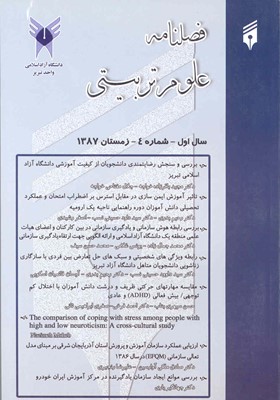مقایسه مقابله با استرس در بین افراد با نوروتیسم بالا و پایین: مطالعه بین فرهنگی
محورهای موضوعی : روانشناسی تربیتی
1 - Department of Psychology, Islamic Azad University- Tabriz Branch, Tabriz, Iran
کلید واژه: استرس, روان رنجور, بین فرهنگی, راههای مقابله,
چکیده مقاله :
به منظور مطالعه تفاوت در مقابله با استرس در بین دانشجویان با روانرنجورخویی بالا و پایین، داده ها از 200 نفر دانشجوی مرد و زن ایرانی و 200 نفردانشجوی مرد و زن هندی در دامنه سنی 20 الی 27 جمع آوری گردید. در بین دانشجویان مرد ایرانی تست من ویتنی-یو نشان داد مردانی که نمرات روانرنجورخویی بالایی داشتند در روش مقابله ای اجتناب- فرار(z = 2.12, p<0.05) نمرات بالاتری کسب کردند. در بین زنان هندی کسانیکه نمرات روانرنجورخویی بالاتری داشتند در روش مفابله ای اجتناب- فرار(z = 2.15, p<0.05) و قبول مسئولیت (z =3.43, p<0.01) نمرات بالاتری آوردند. در بین دانشجویان مرد هندی آنهائی که نمره روانرنجورخویی پایینتری داشتند نمرات بالاتری در شیوه مقابله ای ارزیابی مجدد مثبت(z = 2.31, p<0.01) به دست آوردند . هیچ تفاوت معناداری در مقابله با استرس بین دانشجویان زن ایرانی که نمرات پایین و بالایی در روانرنجورخوریی داشتند به دست نیامد.
In order to study the differences on coping with stress among students with high and low neuroticism, data were collected from 200 Iranian males and females and 200 Indian males and females. Among Iranian males Mann-Whitney U test showed that males with high neuroticism scored higher on escape avoidance way of coping with stress (z = 2.12, p<0.05), among Indian females those with higher neuroticism scored higher on escape avoidance coping (z= 2.15, p<0.05) and accepting responsibility (z =3.43, p<0.01) and among Indian males those with lower neuroticism scored higher on positive reappraisal (z = 2.31, p<0.01) than those with higher neuroticism. No significant differences were found on coping with stress among Iranian females with low and high neuroticism.
- Costa, P.T., Jr., & Widiger, T.A. (ED.). (1994). Personality disorders and the five factor model of personality. Washington, DC: American Psychological Association.
- Costa, P.T., Jr., & McCrae, R.R. (1987a). Neuroticism, somatic complaints, and disease: Is the bark worse than bite? Journal of Personality. 55, 229-316.
- Friedman, H.S., & Booth-Kewely, S. (1987b). The “disease prone” personality. A meta-analytic view of the construct. Amer. Psycho.42, 539,55.
- Hart, K.E., & Hittner, J.B. (1995). Optimism and Pessimism: Associations to coping and anger reactivity. Journal of Personality and Individual Differences. Vol 19(6): 827-839.
- Kardum, I., & Krapic, N.(2001). Personality traits, stressful life events, and coping styles in early adolescence. Journal of personality and Individual differences. 503-515.
- Lazarus, R.S., & Folkman, S. (1984). Stress, Appraisal, and Coping. New York: Springer.
- McCrae, R.R., & Costa, P.T., Jr. (1986). Personality, coping and coping effectiveness in adult sample. Journal of Personality, 54,385-405.
- Tellegen, A. (1985). Structures of mood and Personality and their relevance to assessing anxiety, with an emphasis on self-report. In R.C. Carson., J.N. Buthcher., &S. Minika. (1998). Abnormal psychology and modern life. New York: Addison-Wesley Educational Publishers Inc.

